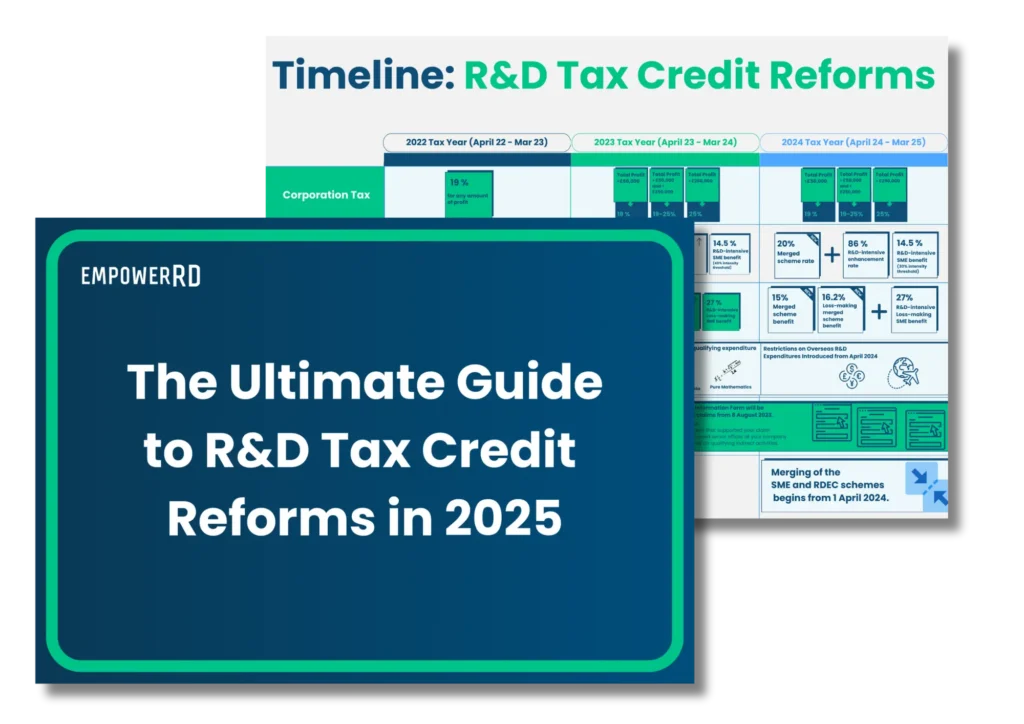The R&D tax relief landscape has undergone significant reforms recently, as evidenced by HMRC’s latest 2022-23 tax year statistics. For the first time since the scheme began in 2000, we see a sharp decline (21%) in submitted claims compared to the 2021-22 tax year. This decline stems largely from stricter compliance measures, notably the new Additional Information Form (AIF), introduced on 8th August 2023.
However, despite fewer claims, the total tax relief remains steady, thanks to a rise in average claim values. These developments highlight the evolving nature of R&D tax relief and the impact of reform efforts.
Understanding the decline in R&D claims
With new compliance measures in place since 2021, it’s unsurprising that HMRC has revised the number of claims for 2021-22 down from the anticipated 90,315 to 83,240, falling below the 2020-21 figures. This decline has now persisted into 2022-2023:
- Total claims dropped by 21%, to 65,690.
- SME scheme claims fell by 23%, from 71,850 to 55,325.
- RDEC claims reduced by 9%, from 11,390 to 10,365.
The decline in R&D claims, especially within the SME scheme, can be traced back to the introduction of the Additional Information Form (AIF) on August 8, 2023. This form, requiring detailed submissions, not only deterred dubious claims but also discouraged some legitimate claimants who found its complexity overwhelming. As many companies were unprepared for this change, many claims were rejected due to incomplete submissions.
This shift underscores the crucial role of R&D advisors, who provide invaluable support by guiding businesses through the intricate and evolving claims process. By ensuring that companies can confidently secure the benefits they deserve, these advisors can help maintain a fair and transparent R&D tax relief system.
Stability in R&D tax relief
Despite a notable reduction in claim numbers for 2022-2023, the total R&D tax relief claimed has shown resilience, increasing slightly to £7.5 billion, up from £7.4 billion the previous year, which have compensated for fewer submissions.
Key insights:
- Overall relief increase: The total relief increase is driven by a rise in average claim values rather than claim volume.
- SME Scheme:
- Claims fell by 23%, but the average claim size jumped by 26%.
- 2022-2023 average claim: £81,247, up from £64,321 in 2021-2022.
- RDEC Scheme:
- Experienced a 7% increase in total relief.
- Average claim size rose by 18%, reaching £291,365 from £246,581 in the prior year.
This increase in average claim sizes points to a trend: smaller claims (under £50,000) have reduced, while larger claims (over £250,000) have increased, leading to a 28% rise in the overall average claim value. This trend is particularly notable in the RDEC scheme, which reflects a shift towards more substantial, compliance-driven claims, especially for larger, more complex projects.
Rise in R&D Expenditure
R&D expenditure in 2022-2023 rose by 4% to £46.7 billion, illustrating ongoing investment in innovation despite stricter compliance. Companies under the RDEC scheme accounted for 65% of this total, underscoring the increasing role of larger companies in the R&D space.
Regional concentrations and industry trends
London remains the leading region, with:
- 23% of all claims
- 32% of the total relief, equating to £2.4 billion
The South East follows, contributing 15% of claims and 18% of the relief, totalling £1.35 billion. In sector terms, Information & Communication leads with 25% of claims, followed closely by Manufacturing. The Professional, Scientific & Technical sector, though responsible for 17% of claims, significantly contributes to the total relief, highlighting the high value of R&D in these fields.
First-time applicants and focus on larger claims
The number of first-time applicants has decreased:
- The SME scheme dropped by 19% to 13,135 new claimants.
- The RDEC scheme saw an 11% reduction to 2,545 new entrants.
This decline suggests that stricter compliance measures, such as the Additional Information Form (AIF), are adding complexity to the claims process, potentially deterring smaller, first-time claimants. New companies, particularly SMEs with limited resources, may find the administrative burden overwhelming, resulting in fewer entries.
With the recent introduction of the Claim Notification Form, which requires first-time claimants to pre-notify HMRC of their intent to claim, we could see this number decrease even further. To learn more about this process, read our detailed blog on the Claim Notification Form
Looking ahead to 2024
With the introduction of the Enhanced R&D Intensive Support (ERIS) scheme and the merging of R&D schemes in April 2024, the landscape is set for more changes. These reforms, particularly impactful for SMEs, will be closely watched as businesses adjust to the new system.
Preparing for the future
The 2022-2023 tax year marks a pivotal moment for the R&D tax relief scheme. While the number of claims has decreased, the stability in relief amounts suggests a shift towards an environment that rewards genuine R&D and innovation.
As we edge closer to 2024, staying informed and compliant is crucial for businesses claiming R&D tax relief benefits. Reassessing your R&D claims process and utilising guidance from expert R&D advisors will be key in navigating this evolving landscape.
Take Action with EmpowerRD
At EmpowerRD, we help businesses unlock the full potential of R&D tax relief. With over 1,200 innovative companies successfully claiming more than £250 million, we blend the expertise of R&D specialists with a cutting-edge R&D platform to ensure your claims are compliant and optimised. Our process simplifies cost collection, gathers technical data, and fosters seamless collaboration within your organisation, creating a clear data trail. This allows our experts to focus on what matters most — ensuring your claim is compliant and optimised. Get in touch and let us guide your business confidently through the complexities of the R&D tax relief landscape.












